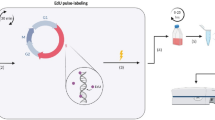Background and Purpose:
Cell-cycle regulation and checkpoint activation are crucial factors for radiation-induced DNA damage processing. The G2/M phase arrest was assessed in lymphoblastoid cell lines and phytohemagglutinin-stimulated T-lymphocytes of different radiosensitivities to study the relationship of G2/M arrest to radiosensitivity.
Material and Methods:
G2/M arrest was analyzed after in vitro irradiation by 2 and 5 Gy of ionizing radiation up to 6 days using 17 lymphoblastoid cell lines from healthy individuals, ataxia-telangiectasia (AT) patients, Nijmegen breakage syndrome (NBS) patients and cancer patients with clinically increased radiosensitivity. In a second approach, phytohemagglutinin-stimulated T-lymphocytes from 15 healthy individuals, twelve cancer patients, and five cancer patients hypersensitive to ionizing radiation were studied. Image cytometry was performed to analyze G2/M arrest.
Results:
Two of the three AT cell lines showed markedly increased G2/M arrest compared to controls. NBS cells were comparable to controls up to day 3, but then demonstrated a slightly increased G2/M arrest. Two of the six radiosensitive lymphoblast cell lines and the five radiosensitive cancer patients' T-lymphocytes assayed showed a reduction in G2/M arrest, while healthy individuals showed no difference from cancer patients.
Conclusion:
The interrelation between G2/M arrest and radiosensitivity is not readily apparent since a variety of radiosensitive cells from patients with radiosensitive syndromes and patients identified as radiosensitive following radiation treatment showed inconsistent G2/M arrest dynamics. Secondary effects, like loss of clonogenicity, G1/S phase arrest and failure of G2/M arrest may contribute to variation of the G2/M arrest endpoint and obscure assessment of cellular radiosensitivity using this method.
Hintergrund und Ziel:
Die Zellzyklusregulation und Aktivierung der Kontrollpunkte des Zellzyklus sind für die strahleninduzierte DNA-Schadensbearbeitung wichtig. Hier wurde der G2/M-Arrest in Zellen unterschiedlicher Strahlenempfindlichkeit verglichen.
Material und Methodik:
Der G2/M-Arrest wurde nach In-vitro-Bestrahlung bei 17 lymphoblastoiden Zelllinien von gesunden Personen, homozygoten Patienten für Ataxia teleangiectatica (AT), Nijmegen-Breakage-Syndrom (NBS) und klinisch erhöht strahlenempfindlichen Patienten sowie bei phytohämagglutininstimulierten T-Lymphozyten von 15 Gesunden, zwölf Krebspatienten und fünf erhöht strahlenempfindlichen Patienten untersucht. Der G2/M-Arrest wurde mit der Image-Zytometrie bestimmt.
Ergebnisse:
In zwei der drei AT-Zelllinien war der G2/M-Arrest im Vergleich zu den Kontrollen deutlich verstärkt. NBS-Zellen waren bis zu 3 Tage nach Bestrahlung vergleichbar mit Kontrollen und reagierten dann mit einem leicht erhöhten G2/M-Arrest. Zwei der sechs strahlenempfindlichen lymphoblastoiden Zelllinien und die T-Lymphozyten der fünf erhöht strahlenempfindlichen Patienten wiesen einen verringerten G2/M-Arrest auf. Zwischen den T-Lymphozyten der gesunden Personen und Krebspatienten bestand kein Unterschied.
Schlussfolgerung:
Der Zusammenhang zwischen der Höhe des G2/M-Arrests und der Strahlenempfindlichkeit ist nicht so eindeutig, da Zellen von Patienten mit Strahlenempfindlichkeitssyndromen und klinisch strahlenempfindliche Patienten einen unterschiedlichen G2/M-Arrest zeigten. Effekte wie Zellinaktivierung, ein erhöhter G1-Arrest und ein verminderter G2/M-Arrest könnten dazu beitragen, dass strahlenempfindliche Patienten mit dieser Methode schwierig zu identifizieren sind.
Similar content being viewed by others
Author information
Authors and Affiliations
Corresponding author
Rights and permissions
About this article
Cite this article
Perez, A., Grabenbauer, G.G., Sprung, C.N. et al. Potential for the G2/M Arrest Assay to Predict Patient Susceptibility to Severe Reactions Following Radiotherapy. Strahlenther Onkol 183, 99–106 (2007). https://doi.org/10.1007/s00066-007-1565-9
Received:
Revised:
Issue Date:
DOI: https://doi.org/10.1007/s00066-007-1565-9




